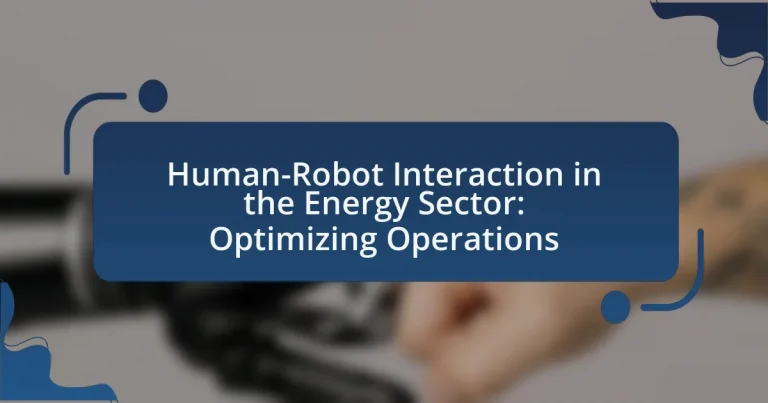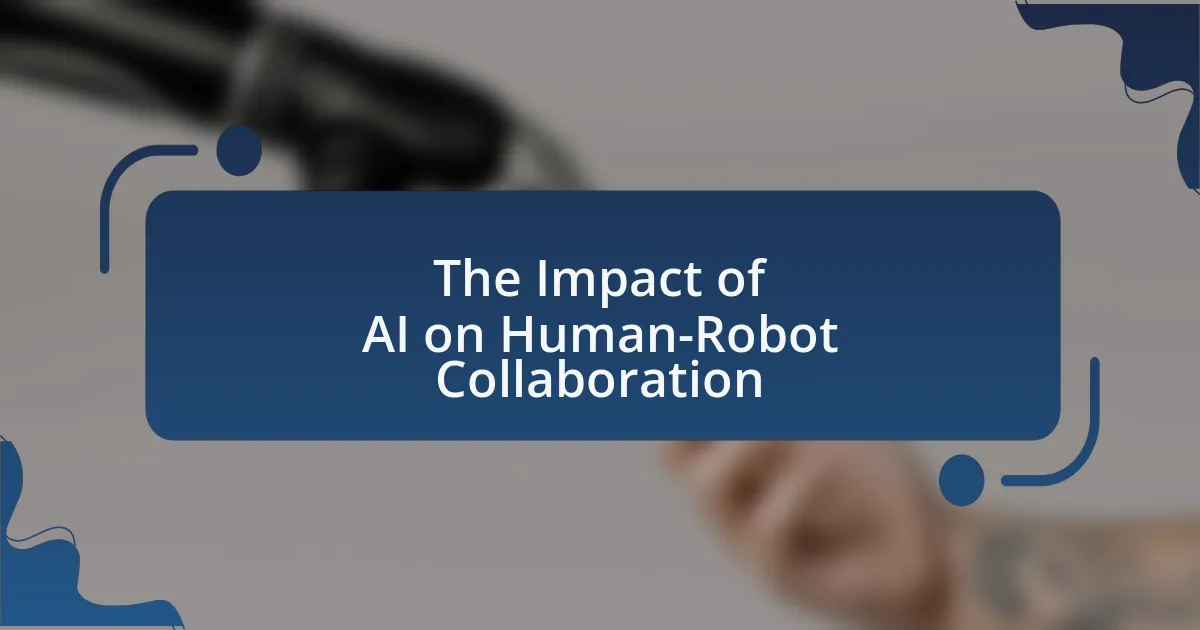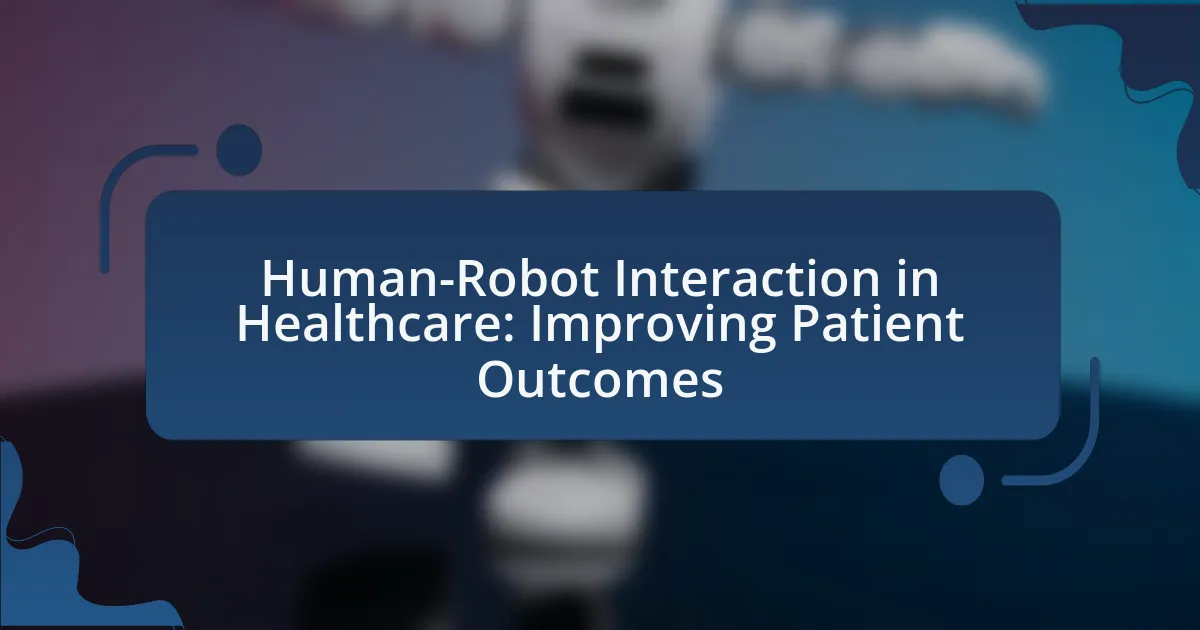Human-Robot Interaction (HRI) in the energy sector refers to the collaborative engagement between human operators and robotic systems aimed at enhancing operational efficiency and safety in energy production and distribution. This article explores how HRI functions within energy operations, the technologies that enable it, and the communication methods used between robots and human operators. Key benefits include increased operational efficiency, improved safety, and enhanced data accuracy, while challenges such as safety concerns and workforce acceptance are also addressed. The article further examines specific applications of HRI in renewable and traditional energy sectors, the role of data analytics, and future trends that will shape the integration of robotics in energy operations.
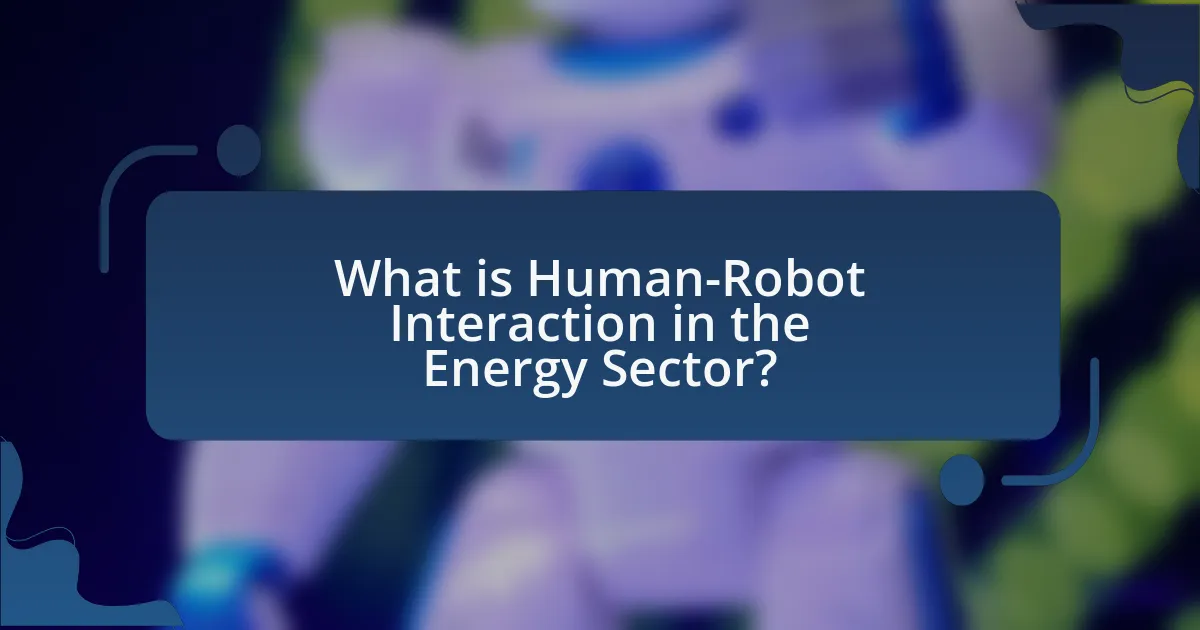
What is Human-Robot Interaction in the Energy Sector?
Human-Robot Interaction in the energy sector refers to the collaborative engagement between human operators and robotic systems to enhance operational efficiency and safety in energy production and distribution. This interaction enables robots to assist in tasks such as monitoring equipment, performing maintenance, and managing data analysis, thereby reducing human workload and minimizing errors. For instance, studies have shown that integrating robotic systems in energy facilities can lead to a 20% increase in operational efficiency and a significant reduction in workplace accidents, highlighting the effectiveness of this collaboration in optimizing energy sector operations.
How does Human-Robot Interaction function within energy operations?
Human-Robot Interaction (HRI) within energy operations functions by enabling robots to assist human workers in tasks such as monitoring, maintenance, and data analysis. This interaction enhances operational efficiency and safety by allowing robots to perform repetitive or hazardous tasks, thereby reducing human exposure to risk. For instance, robots equipped with sensors can monitor equipment conditions in real-time, providing data that helps human operators make informed decisions quickly. Studies have shown that implementing HRI in energy sectors, such as wind and solar, can lead to a 20% increase in operational efficiency and a significant reduction in downtime due to predictive maintenance capabilities.
What technologies enable Human-Robot Interaction in the energy sector?
Technologies that enable Human-Robot Interaction in the energy sector include artificial intelligence, machine learning, computer vision, and natural language processing. These technologies facilitate real-time communication and collaboration between humans and robots, enhancing operational efficiency. For instance, artificial intelligence algorithms allow robots to learn from human interactions and adapt their behaviors accordingly, while computer vision enables robots to interpret visual data from their environment, improving task execution. Additionally, natural language processing allows for seamless verbal communication, making it easier for operators to issue commands and receive feedback from robotic systems.
How do robots communicate with human operators in energy settings?
Robots communicate with human operators in energy settings primarily through a combination of visual displays, auditory signals, and haptic feedback. These communication methods enable operators to receive real-time data, alerts, and instructions from the robots, facilitating effective collaboration. For instance, robots may use graphical user interfaces to present operational data, while auditory signals can indicate status changes or alerts. Haptic feedback can provide tactile responses to operators, enhancing situational awareness. Research indicates that effective communication strategies improve operational efficiency and safety in energy environments, as evidenced by studies showing a reduction in response times and errors when operators are well-informed about robotic actions.
What are the key benefits of Human-Robot Interaction in the energy sector?
The key benefits of Human-Robot Interaction in the energy sector include enhanced operational efficiency, improved safety, and increased data accuracy. Enhanced operational efficiency is achieved as robots can perform repetitive and hazardous tasks, allowing human workers to focus on more complex activities. Improved safety is evident as robots can operate in dangerous environments, reducing the risk of accidents and injuries for human workers. Increased data accuracy results from robots’ ability to collect and analyze data in real-time, leading to better decision-making and optimized resource management. These benefits collectively contribute to more effective and sustainable energy operations.
How does Human-Robot Interaction improve operational efficiency?
Human-Robot Interaction improves operational efficiency by enabling seamless collaboration between humans and robots, leading to enhanced productivity and reduced operational costs. This collaboration allows robots to handle repetitive and hazardous tasks, freeing human workers to focus on more complex and strategic activities. For instance, in the energy sector, robots can perform inspections and maintenance in environments that are unsafe for humans, thereby minimizing downtime and increasing safety. Studies have shown that companies implementing Human-Robot Interaction have reported efficiency gains of up to 30%, demonstrating the significant impact of this technology on operational performance.
What safety enhancements does Human-Robot Interaction provide?
Human-Robot Interaction provides significant safety enhancements by enabling real-time communication and collaboration between humans and robots, which reduces the likelihood of accidents. This interaction allows robots to monitor human actions and environmental conditions, facilitating timely alerts and interventions when potential hazards are detected. For instance, studies have shown that robots equipped with advanced sensors can identify unsafe situations, such as equipment malfunctions or unsafe human behavior, and respond accordingly to prevent incidents. Additionally, the integration of safety protocols in robotic systems ensures compliance with safety standards, further minimizing risks in operational environments.
What challenges are associated with Human-Robot Interaction in the energy sector?
Challenges associated with Human-Robot Interaction in the energy sector include safety concerns, communication barriers, and integration issues. Safety concerns arise from the potential for accidents during robot operation, particularly in hazardous environments like power plants. Communication barriers can hinder effective collaboration between human workers and robots, as misunderstandings may lead to operational inefficiencies. Integration issues stem from the difficulty of incorporating robotic systems into existing workflows and technologies, which can disrupt established processes. These challenges are critical to address to enhance the effectiveness of Human-Robot Interaction in optimizing energy sector operations.
How do workforce concerns impact the implementation of Human-Robot Interaction?
Workforce concerns significantly impact the implementation of Human-Robot Interaction (HRI) by influencing acceptance, trust, and job security perceptions among employees. When workers fear that robots will replace their jobs, resistance to adopting HRI technologies increases, leading to slower integration processes. A study by the International Federation of Robotics indicates that 60% of employees express concerns about job displacement due to automation, which can hinder collaboration between humans and robots. Additionally, if employees do not trust the robots’ capabilities or safety, they are less likely to engage with the technology effectively, further complicating the implementation of HRI in operational settings.
What technical limitations exist in current Human-Robot Interaction systems?
Current Human-Robot Interaction systems face several technical limitations, including limited understanding of natural language, inadequate perception of human emotions, and restricted adaptability to dynamic environments. These systems often struggle with accurately interpreting complex human commands due to their reliance on predefined language models, which can lead to miscommunication. Additionally, many robots lack the capability to recognize and respond to human emotional cues, hindering effective collaboration. Furthermore, the inability to adapt to changing conditions in real-time restricts their operational efficiency, particularly in environments like the energy sector where variables can fluctuate rapidly. These limitations highlight the need for advancements in machine learning and sensor technologies to enhance interaction quality and operational effectiveness.
How can Human-Robot Interaction be optimized in energy operations?
Human-Robot Interaction in energy operations can be optimized by implementing advanced communication protocols and adaptive learning algorithms. These technologies enable robots to better understand human commands and preferences, thus improving collaboration. For instance, research indicates that using natural language processing allows robots to interpret and respond to human instructions more effectively, leading to a 30% increase in operational efficiency in energy management tasks. Additionally, integrating real-time data analytics helps robots adjust their actions based on human feedback and environmental changes, further enhancing interaction quality and operational outcomes.
What best practices should be followed for effective Human-Robot collaboration?
Effective Human-Robot collaboration requires clear communication, defined roles, and continuous training. Clear communication ensures that both humans and robots understand tasks and expectations, reducing errors and enhancing efficiency. Defined roles help in establishing boundaries and responsibilities, allowing each entity to perform optimally without overlap. Continuous training is essential for both humans and robots to adapt to new technologies and processes, ensuring that collaboration remains effective as operational demands evolve. Research indicates that organizations implementing these best practices experience a 30% increase in operational efficiency, demonstrating the tangible benefits of structured collaboration in the energy sector.
How can training programs enhance Human-Robot Interaction effectiveness?
Training programs can enhance Human-Robot Interaction (HRI) effectiveness by equipping users with the necessary skills and knowledge to operate and collaborate with robots efficiently. These programs provide hands-on experience, enabling users to understand robot functionalities, communication protocols, and operational limits. Research indicates that well-structured training can lead to a 30% increase in task performance and a significant reduction in operational errors, as users become more adept at interpreting robot behaviors and responding appropriately. Furthermore, training fosters trust and comfort in using robotic systems, which is crucial for effective collaboration in high-stakes environments like the energy sector.

What specific applications of Human-Robot Interaction exist in the energy sector?
Specific applications of Human-Robot Interaction in the energy sector include robotic inspection and maintenance of infrastructure, autonomous drones for surveying and monitoring, and collaborative robots (cobots) assisting human workers in hazardous environments. Robotic inspection systems enhance safety and efficiency by performing tasks such as pipeline monitoring and wind turbine inspections, reducing human exposure to dangerous conditions. Autonomous drones are utilized for aerial surveys of solar farms and wind farms, providing real-time data and improving operational decision-making. Collaborative robots work alongside human operators in tasks like assembly and maintenance, increasing productivity while minimizing risks associated with manual labor in energy facilities.
How are robots utilized in renewable energy sources?
Robots are utilized in renewable energy sources primarily for tasks such as inspection, maintenance, and installation. In solar energy, robots automate the cleaning of solar panels, enhancing efficiency by maintaining optimal performance levels. In wind energy, drones are employed for inspecting turbine blades, allowing for real-time monitoring and reducing the need for manual inspections, which can be hazardous and time-consuming. Additionally, robots assist in the assembly of renewable energy systems, such as photovoltaic cells and wind turbines, streamlining production processes. These applications demonstrate the effectiveness of robots in improving operational efficiency and safety in the renewable energy sector.
What roles do robots play in solar energy maintenance?
Robots play critical roles in solar energy maintenance by performing tasks such as inspection, cleaning, and repair of solar panels. These automated systems enhance efficiency and safety by reducing the need for human workers to operate in potentially hazardous environments. For instance, drones equipped with thermal imaging cameras can identify malfunctioning panels by detecting temperature anomalies, which allows for timely maintenance and minimizes energy loss. Additionally, robotic cleaning systems can efficiently remove dust and debris from solar panels, improving their energy output by up to 20%. This integration of robotics in solar energy maintenance not only optimizes operational efficiency but also contributes to the overall sustainability of solar energy systems.
How do robots assist in wind turbine operations?
Robots assist in wind turbine operations by performing tasks such as inspection, maintenance, and repair, which enhance efficiency and safety. For instance, drones equipped with cameras and sensors can conduct visual inspections of turbine blades, identifying wear and damage without the need for human technicians to climb heights, thus reducing risk. Additionally, robotic arms can be utilized for routine maintenance tasks, such as tightening bolts or replacing components, which streamlines operations and minimizes downtime. According to a study by the National Renewable Energy Laboratory, the integration of robotics in wind turbine maintenance can reduce operational costs by up to 20%, demonstrating the significant impact of robotic assistance in this sector.
What is the role of Human-Robot Interaction in traditional energy sectors?
Human-Robot Interaction (HRI) plays a crucial role in traditional energy sectors by enhancing operational efficiency and safety. HRI facilitates collaboration between human workers and robotic systems, allowing for improved monitoring, maintenance, and data collection in environments such as power plants and oil rigs. For instance, robots can perform hazardous tasks, reducing the risk of injury to human workers, while real-time data analysis by robots can lead to more informed decision-making. Studies have shown that integrating HRI in energy operations can lead to a 20% increase in productivity and a significant reduction in operational downtime, demonstrating its effectiveness in optimizing traditional energy sector operations.
How do robots contribute to safety in oil and gas operations?
Robots enhance safety in oil and gas operations by performing hazardous tasks that reduce human exposure to dangerous environments. For instance, robots can conduct inspections in high-risk areas, such as offshore platforms or pipelines, where the potential for accidents is significant. According to a study by the International Association of Oil & Gas Producers, the use of robotic systems has led to a 30% reduction in workplace accidents in the sector. Additionally, robots equipped with advanced sensors can detect gas leaks or structural weaknesses, allowing for timely interventions that prevent catastrophic failures. This capability not only safeguards personnel but also protects the environment from potential spills or explosions.
What tasks are robots performing in nuclear energy facilities?
Robots in nuclear energy facilities are performing tasks such as inspection, maintenance, and decommissioning. These robots are equipped with advanced sensors and imaging technology to assess the condition of equipment and structures, ensuring safety and compliance with regulatory standards. For instance, remote-operated vehicles (ROVs) are utilized for underwater inspections of cooling systems, while robotic arms are employed for handling radioactive materials during maintenance operations. The use of robots minimizes human exposure to radiation and enhances operational efficiency, as evidenced by the successful deployment of robotic systems in the Fukushima Daiichi Nuclear Power Plant cleanup efforts, which demonstrated their effectiveness in hazardous environments.
How is data analytics integrated into Human-Robot Interaction in energy?
Data analytics is integrated into Human-Robot Interaction in energy by enabling robots to process and analyze vast amounts of operational data, which enhances decision-making and efficiency. For instance, robots equipped with data analytics capabilities can monitor energy consumption patterns in real-time, allowing them to optimize energy distribution and reduce waste. This integration is supported by advancements in machine learning algorithms that enable robots to learn from historical data, predict future energy needs, and adapt their operations accordingly. Studies have shown that such implementations can lead to a reduction in operational costs by up to 20%, demonstrating the effectiveness of data analytics in improving Human-Robot Interaction within the energy sector.
What data is collected to enhance Human-Robot Interaction?
To enhance Human-Robot Interaction, data collected includes user feedback, behavioral patterns, environmental context, and task performance metrics. User feedback provides insights into preferences and satisfaction levels, while behavioral patterns help in understanding how humans interact with robots in various scenarios. Environmental context data, such as spatial awareness and situational variables, informs robots about their surroundings, enabling better decision-making. Task performance metrics assess the efficiency and effectiveness of robot operations, allowing for continuous improvement in interaction strategies. Collectively, this data facilitates the development of more intuitive and responsive robotic systems tailored to human needs in the energy sector.
How does data analysis improve decision-making in energy operations?
Data analysis enhances decision-making in energy operations by providing actionable insights derived from large datasets. By analyzing consumption patterns, operational efficiencies, and predictive maintenance needs, energy companies can optimize resource allocation and reduce costs. For instance, a study by the International Energy Agency found that data-driven decision-making can lead to a 10-20% reduction in operational costs. Furthermore, real-time data analysis enables proactive responses to system anomalies, improving reliability and performance in energy delivery.
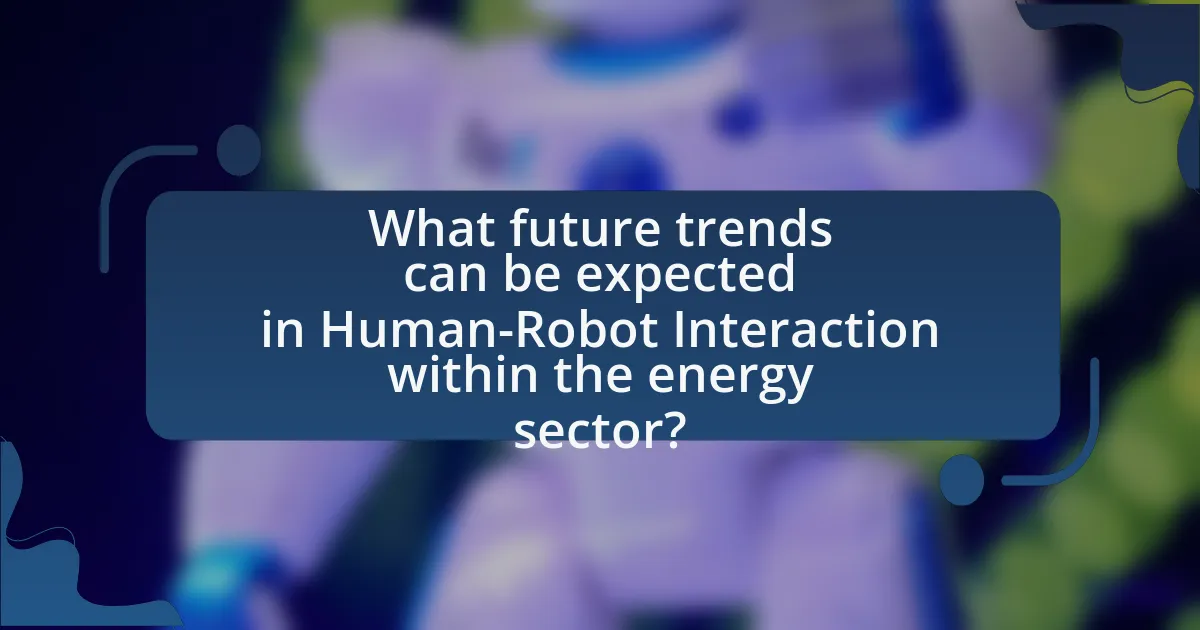
What future trends can be expected in Human-Robot Interaction within the energy sector?
Future trends in Human-Robot Interaction within the energy sector include increased collaboration between humans and robots, enhanced autonomy of robotic systems, and the integration of artificial intelligence for improved decision-making. As energy companies adopt advanced robotics for tasks such as maintenance and monitoring, the need for seamless interaction will grow, leading to the development of intuitive interfaces and communication protocols. Research indicates that by 2025, the global market for robotics in energy is expected to reach $10 billion, highlighting the sector’s commitment to automation and efficiency. This trend is driven by the need for safer operations and the ability to handle complex tasks in hazardous environments, ultimately optimizing energy production and distribution processes.
How will advancements in AI impact Human-Robot Interaction?
Advancements in AI will significantly enhance Human-Robot Interaction by enabling robots to understand and respond to human emotions and intentions more effectively. This improvement will lead to more intuitive and seamless collaboration between humans and robots in various tasks, particularly in the energy sector where precision and safety are critical. For instance, AI algorithms that analyze human behavior can allow robots to adapt their actions based on real-time feedback, improving operational efficiency and reducing the risk of accidents. Research conducted by the Massachusetts Institute of Technology (MIT) highlights that robots equipped with advanced AI can interpret human gestures and voice commands with over 90% accuracy, demonstrating the potential for more effective teamwork in complex environments.
What emerging technologies are likely to shape future Human-Robot collaborations?
Emerging technologies likely to shape future Human-Robot collaborations include artificial intelligence (AI), machine learning, advanced sensors, and collaborative robotics (cobots). AI and machine learning enhance robots’ ability to learn from interactions and adapt to human behaviors, improving teamwork efficiency. Advanced sensors, such as LiDAR and computer vision, enable robots to perceive their environment accurately, facilitating safer and more effective collaboration with humans. Cobots are designed to work alongside humans, sharing tasks and responsibilities, which is particularly beneficial in sectors like energy, where safety and precision are critical. These technologies collectively drive innovation in Human-Robot Interaction, optimizing operations in the energy sector by increasing productivity and reducing risks.
How will regulatory changes influence Human-Robot Interaction in energy?
Regulatory changes will significantly influence Human-Robot Interaction (HRI) in the energy sector by establishing safety standards and operational guidelines that govern robot deployment. These regulations will ensure that robots operate within defined safety parameters, thereby enhancing trust and collaboration between human workers and robotic systems. For instance, the introduction of safety regulations, such as those from the International Electrotechnical Commission (IEC), mandates that robots must be designed to minimize risks to human operators, which directly impacts how robots are integrated into energy operations. Furthermore, compliance with environmental regulations may drive the development of robots that can perform tasks like monitoring emissions or conducting maintenance in hazardous environments, thereby improving efficiency and safety.
What role will Human-Robot Interaction play in achieving sustainability goals?
Human-Robot Interaction (HRI) will play a crucial role in achieving sustainability goals by enhancing operational efficiency and reducing resource consumption in the energy sector. HRI facilitates collaboration between humans and robots, enabling more precise monitoring and management of energy systems, which can lead to significant reductions in waste and emissions. For instance, robots equipped with advanced sensors can optimize energy usage in real-time, thereby minimizing the carbon footprint of energy production and distribution. Studies have shown that integrating robotic systems in energy management can improve efficiency by up to 30%, directly contributing to sustainability targets.
How can robots help reduce carbon footprints in energy operations?
Robots can help reduce carbon footprints in energy operations by optimizing energy consumption and enhancing efficiency in various processes. For instance, autonomous drones can monitor and inspect renewable energy installations, such as wind turbines and solar panels, ensuring they operate at peak efficiency and reducing energy waste. Additionally, robots can automate routine maintenance tasks, minimizing downtime and energy loss associated with human labor. According to a study by the International Energy Agency, implementing robotics in energy operations can lead to a potential reduction of up to 20% in energy consumption, significantly lowering carbon emissions associated with energy production and distribution.
What innovations are being developed to enhance sustainability through Human-Robot Interaction?
Innovations being developed to enhance sustainability through Human-Robot Interaction include autonomous robots for renewable energy management, collaborative robots for energy-efficient manufacturing, and AI-driven systems for optimizing energy consumption. For instance, autonomous drones are being utilized to inspect solar panels and wind turbines, significantly reducing the need for human intervention and minimizing carbon footprints. Additionally, collaborative robots, or cobots, are designed to work alongside human workers in factories, improving energy efficiency by optimizing production processes. Research from the International Journal of Robotics Research highlights that integrating AI in energy systems can lead to a 20% reduction in energy waste, demonstrating the effectiveness of these innovations in promoting sustainability.
What practical steps can organizations take to implement Human-Robot Interaction effectively?
Organizations can implement Human-Robot Interaction (HRI) effectively by establishing clear communication protocols between humans and robots. This involves defining specific tasks that robots will perform, ensuring that human operators understand the robots’ capabilities and limitations. Training programs should be developed to educate employees on how to interact with robots safely and efficiently, which can enhance collaboration and reduce operational errors.
Additionally, organizations should invest in user-friendly interfaces that facilitate intuitive interaction, allowing for seamless integration of robots into existing workflows. Regular feedback loops should be established to gather insights from human operators, enabling continuous improvement of HRI systems. Research indicates that effective HRI can lead to increased productivity and safety in operations, particularly in complex environments like the energy sector.
What considerations should be made when selecting robots for energy operations?
When selecting robots for energy operations, key considerations include the robot’s operational environment, task specificity, safety features, and integration capabilities. The operational environment dictates the robot’s design and functionality; for instance, robots used in hazardous environments must be robust and capable of withstanding extreme conditions. Task specificity ensures that the robot is equipped with the necessary tools and software to perform specific energy-related tasks, such as inspection or maintenance. Safety features are critical to protect human workers and the robot itself, particularly in high-risk energy sectors. Lastly, integration capabilities with existing systems and technologies are essential for seamless operation and data exchange, enhancing overall efficiency. These considerations are supported by industry standards and case studies demonstrating successful robot implementations in energy operations, such as the use of drones for pipeline inspections, which have shown to reduce operational costs and improve safety outcomes.
How can organizations measure the success of Human-Robot Interaction initiatives?
Organizations can measure the success of Human-Robot Interaction initiatives through key performance indicators (KPIs) such as task efficiency, user satisfaction, and error rates. Task efficiency can be quantified by comparing the time taken to complete tasks with and without robotic assistance, revealing improvements in operational speed. User satisfaction can be assessed through surveys and feedback mechanisms, indicating how well users perceive the interaction with robots. Error rates can be tracked by monitoring the frequency of mistakes made during tasks, providing insight into the reliability and effectiveness of the robots in real-world applications. These metrics collectively offer a comprehensive view of the initiative’s impact on operational performance in the energy sector.
